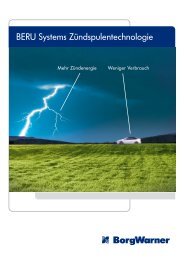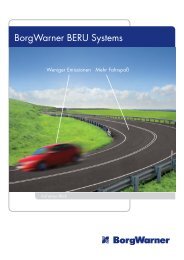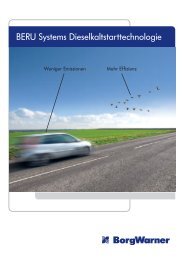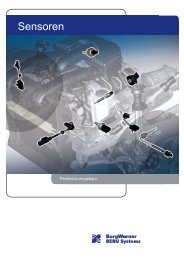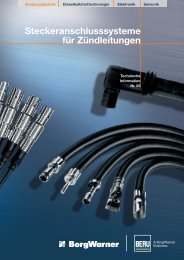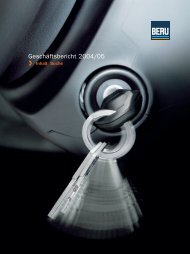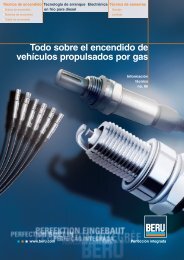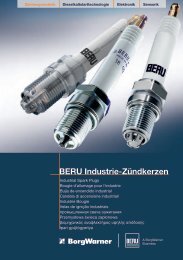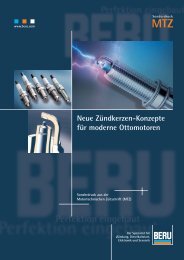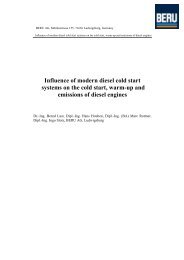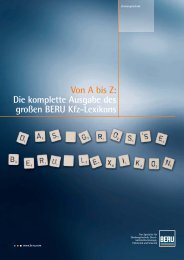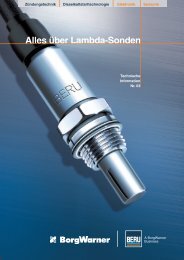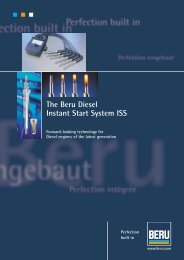WWW Entwicklungen Reifendruck - BorgWarner BERU Systems ...
WWW Entwicklungen Reifendruck - BorgWarner BERU Systems ...
WWW Entwicklungen Reifendruck - BorgWarner BERU Systems ...
Create successful ePaper yourself
Turn your PDF publications into a flip-book with our unique Google optimized e-Paper software.
place using the driver information system<br />
without positional allocation.<br />
4.2 Trigger System<br />
If positional allocation is required in addition<br />
to the wheel electronics, the trigger system<br />
is the best technical solution compared<br />
to the other systems currently on offer.<br />
The added number of components provides<br />
fast and reliable detection of the<br />
wheel positions. The transmitter is controlled<br />
by the central control unit. A trigger<br />
signal causes the allocated wheel electronics<br />
to record a new pressure and temperature<br />
measurement value and to transmit it<br />
as a radio telegram encoded as requested<br />
information.<br />
Allocation to the wheel position is possible<br />
very quickly due to the correlation between<br />
a radio data set registered (marked)<br />
in the central receiver and the trigger request.<br />
The trigger-controlled system provides<br />
the pressure information even before<br />
the driver sets off.<br />
In this system, the target values for the<br />
tire pressures can be specified for each axle<br />
by control unit programming and can also<br />
be derived directly from the set pressures<br />
using a calibration modulator.<br />
A visual indication is given in the display,<br />
which highlights the positional information,<br />
Figure 5.<br />
4.2 Trigger System<br />
4.3 Compact System<br />
Figure 6 shows the components of the actual<br />
TSS.<br />
The latest development continues to reduce<br />
the number of system components.<br />
The Beru compact system (TSS 3rd generation)<br />
will consist only of a central receiver<br />
unit with an integrated control unit function<br />
and four wheel electronic systems.<br />
Positional allocation takes place on<br />
the basis of the rotary direction signal,<br />
which the wheel electronic systems provide<br />
in the radio data, relating the information<br />
on the direction in which the vehicle<br />
is moving, in combination with the<br />
axle-specific separation from the fitted<br />
wheel electronic systems to a comparison<br />
of the various RF reception levels.<br />
This is achieved by the installation of the<br />
central receiver unit at the front or rear of<br />
the vehicle in order to provoke these differences<br />
in the RF level. Definition of the<br />
target value for tire pressure takes place<br />
as described above. A monitor displays<br />
the warning and the positional information.<br />
5 Integration in the Vehicle<br />
Figure 5: Display in the Beru-TSS as used in the Audi A6 showing the<br />
pressure and temperature values in the individual tires<br />
ATZ 2/2005 Jahrgang 107<br />
System integration in the vehicle is divided<br />
into two areas. On the one hand, the best<br />
positions for the hardware in terms of tech-<br />
nical and design aspects must be defined,<br />
and on the other hand the system must be<br />
coupled to the vehicle wiring.<br />
5.1 Installation Space<br />
The potential installation spaces are surveyed<br />
in terms of their radio frequency reception<br />
characteristics in order to identify<br />
the best possible position for installing the<br />
receiver antenna. The most favourable position<br />
is usually in the underbody, in the<br />
bumpers or in the wheel arch. However, if<br />
the vehicle manufacturer so wishes, the antenna<br />
can also be installed in the vehicle interior.<br />
The system is fundamentally designed<br />
so that the reception of the RF signal can also<br />
be guaranteed if the tires provide considerable<br />
attenuation. Additional damping by<br />
environmental influences (snow, rain) is also<br />
considered in the system design.<br />
5.2 Networking<br />
Another factor of the system integration is<br />
the connection of the system to the vehiclespecific<br />
wiring. In most applications, the<br />
control unit is operated in the existing comfort<br />
CAN.<br />
The components of the tire pressure<br />
monitoring system all have a self-diagnosis<br />
capability. The specific manufacturer’s diagnosis<br />
services provide the required diagnosis<br />
information.<br />
The vehicle bus also deals with the operation<br />
and display of the pressure information.<br />
5.3 Technical Specifications<br />
Statutory requirements, for example the<br />
NHTSA initiative and the demands voiced<br />
by vehicle manufacturers, define the<br />
framework for alarm thresholds and response<br />
times.<br />
5.4 Special Features of the<br />
Beru TSS<br />
In addition to the tire pressure, the Beru<br />
Tire Safety System also evaluates the tire<br />
temperature. This is based on the general<br />
gas law. This temperature compensation<br />
means that the alarm threshold can be<br />
aligned with the tire pressure.<br />
A message is issued if the alarm threshold<br />
was exceeded on two successive samples.<br />
Given a typical transmission interval<br />
of one minute, this means that detection<br />
takes no longer than two minutes. If there<br />
are high changes in pressure, the wheel<br />
electronics transmit signals in cycles of<br />
merely a second. In these cases, the detection<br />
period is only two seconds.<br />
In addition to tire defects with rapid loss<br />
of pressure, the system also detects a gradual<br />
loss of pressure – for example due to dif-<br />
7



